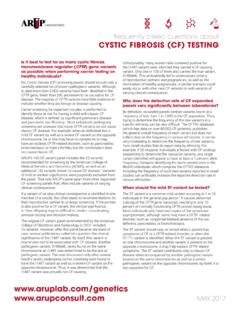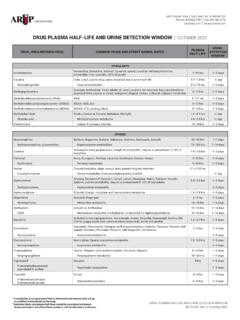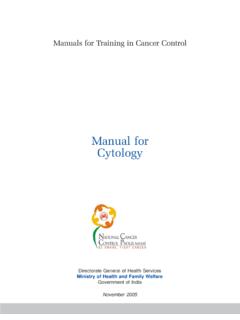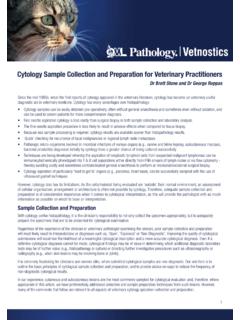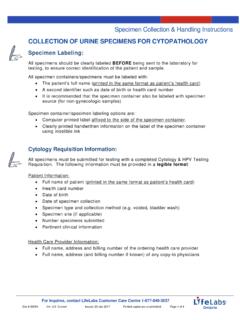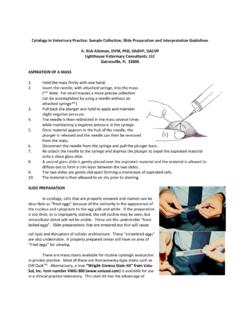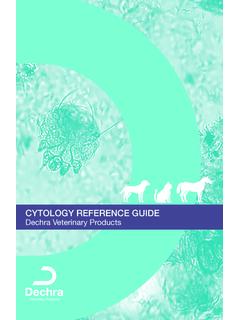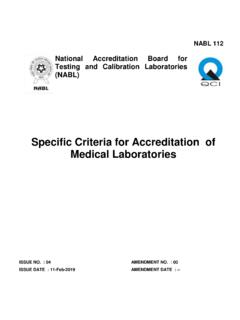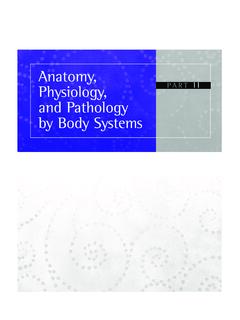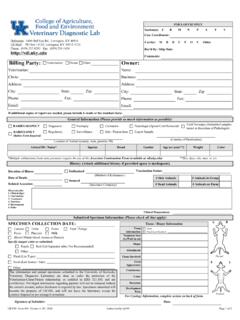Transcription of aruplab.com/transport
1 TRANSPORTSPECIMEN TRANSPORTATION INSTRUCTIONSI nformation in this brochure is current as of June 2021. All content is subject to change. Please contact ARUP Client Services at 800-522-2787 with any questions or LABORATORIESARUP Laboratories is a nonprofit national clinical and anatomic pathology reference laboratory. ARUP processes more than 55,000 specimens of blood, body fluid, and tissue biopsies per day for clients located in all 50 states. ARUP is based in Salt Lake City, Utah, a major metropolitan hub with one of the fastest growing airports in the nation.
2 Currently, eight airlines operate hundreds of daily flights to Salt Lake City International Airport. Shipments arrive continuously, ensuring rapid turnaround times on test results, regardless of where a client s laboratory may be located. Throughout the transportation process, ARUP s Logistics and Transportation Department employs a variety of quality-assurance indicators that monitor and assure specimen pickup and transport to ARUP are managed by ARUP s Logistics and Transportation teams. A representative from a contract courier in the client s area picks up specimens from the client site.
3 In order to optimize specimen integrity, ARUP provides supplies to clients to facilitate proper specimen collection , transfer, and transport . ARUP continuously monitors the shipping regulations of medical specimens established by the International Air transport Association (IATA) and Department of Transportation (DOT) to remain in the most responsive source of quality information and knowledge, ARUP strives to be the reference laboratory of choice for community healthcare systems. ARUP helps its clients meet the customized needs of their unique communities. We believe in collaborating, sharing knowledge, and contributing to laboratory science in ways that provide the best value for the patient.
4 Together, ARUP and its clients will improve patient care today and in the LABELINGAll specimens submitted to ARUP for testing must be appropriately labeled.* This requirement assures positive identification and optimum integrity of patient specimens from the time of collection until testing is completed and results reported. Clients will be notified of inappropriately labeled specimens, which may be returned to the client upon STANDARD transport TUBESARUP encourages the use of ARUP standard transport tubes for specimen submission. These containers have been evaluated by ARUP and are not known to cause analytical interference in the associated assays.
5 ARUP standard transport tubes are also available in an amber color required for light-sensitive tests and metal-free for trace element testing. All ARUP standard transport tubes meet DOT 49 CFR and IATA DGR requirements for the transport of specimens.*The College of American Pathologists (CAP) Laboratory General Checklist requires that all primary specimen containers must be labeled with two identifiers at the time of collection to provide unique identification. Examples of acceptable identifiers include, but are not limited to, the following: patient name, date of birth, hospital number, Social Security number, requisition number, accession number, and unique random number (CAP ).
6 The Joint Commission National Patient Safety Goals require two ways to identify the patient (Goal 1, ).SPECIMEN PREPARATION15824 Standard transport Tube For routine serum, plasma, and urine testing13654 Standard transport Tube, Amber For serum, plasma, whole blood, and urine testing that requires light protection43115 Standard transport Tube, Sterile For CSF and other testing that requires a sterile specimen43116 Standard transport Tube, Metal Free For heavy-metal serum, plasma, and urine testing The tube has graduated markings up to 4 mL, which is the maximum capacity.
7 When submitting specimens, it is critical to leave an air space at the top of the tube to allow for expansion and prevent leakage. For this reason, liquid should never exceed 4 mL. A separate tube must be submitted for each panel or test ordered on the same patient, especially for tests requiring frozen specimens. However, one specimen is sufficient for allergen testing. If specimen requirements indicate more than 4 mL, submit sample in multiple tubes. The tube s threaded cap provides a leakproof seal when screwed on properly. It is not a push-on cap. The label must be adhered as pictured below; hold the lid of the tube in your left hand and place the label lengthwise.
8 Do not use Parafilm laboratory sealing film. ARUP s standard transport tubes are not sterile; do not use them for infectious disease tests requiring sterile transport . All labels should be in compliance with Clinical and Laboratory Standards Institute (CLSI) guidelines (Auto 12-A).For up-to-date specimen preparation and transport information, visit REJECTION/TEST CANCELLATIONC ontainers that are not preferred but may be accepted: Glass tubes for refrigerated and ambient (room temperature) specimens. Glass tubes are not recommended due to the increased risk of broken specimens while in transit and the associated safety concerns for those who handle them.
9 Tubes that use a pop-top type of cap Syringes (where required) that are plastic and have a Luer Lock fitting, which secures the cap. The syringe should be enclosed in two plastic bags and placed in a small cardboard box or plastic jar with a screw cap to protect the plunger from accidental pushing. No needles should be attached. Client-specific containersUnacceptable containers and/or conditions: Glass tubes for frozen specimens Polystyrene tubes Leaking specimens Syringes with needles attached transport tubes secured with Parafilm Specimens received in expired transport containers or media Serum and plasma separator tubes (SST and PST).
10 When a separator tube is used for collection , promptly centrifuge the specimen and pour the serum or plasma into an ARUP standard transport tube before shipping to ARUP, unless otherwise specified. Numerous tests prohibit the use of specimens collected in tubes containing gels. If prohibited, the information will appear for the test entry under Remarks or Unacceptable Conditions in the ARUP Laboratory Test Directory at TRANSPORTATION CONTAINER 95 KPA VALIDATIONAll specimen containers supplied by ARUP for specimen transport withstand stringent testing to ensure they are well constructed and have secure lids that prevent leakage during transport .



